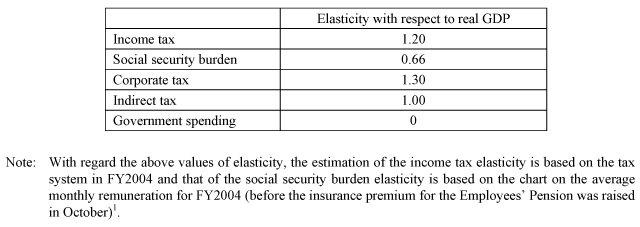Appended Note 1-8 Estimation of structural and cyclical fiscal balances
- Japanese
- English
The structural fiscal balance, the underlying fiscal position when cyclical movements are removed, is computed by treating four types of taxes and a sole item of public spending as cyclically sensitive: Income tax, corporate tax, indirect tax and social security burden, in terms of revenue, and employment insurance payments for expenditure.
It is assumed that economic cycle factors have no effect on the fiscal balance when the economy realizes its potential GDP level. The potential GDP referred to here is a possible production level in a sustainable manner by using labor and capital amounts at a past trend as inputs, as estimated in Appended Note 1-1. The structural fiscal balance is derived by calculating the structural tax revenues and government spendings of each fiscal year under the assumption that the potential GDP is realized from actual tax revenues and government spendings adjusted according to the ratio of potential GDP to actual GDP, and the assumed elasticities of each tax and government spending item.
Structural fiscal balance (estimated value)
= Revenue in accordance with the trend with GDP - Expenditure in accordance with the trend GDP
In particular,

The structural fiscal balance can be derived by summing up the revenue of each tax item and subtracting the government spending from that sum as follows:

Furthermore, elasticity of government spending with respect to GDP ( ) is thought to only reflect the cyclical fluctuation in employment insurance payments. Thus the elasticity,
) is thought to only reflect the cyclical fluctuation in employment insurance payments. Thus the elasticity,  , is derived by multiplying the elasticity of employment insurance payments with respective GDP by the weight of such payments in government spendings. Given that the share of employment employment payments to government spendings as a whole is extremely small, the elasticity of governments spending with respect to GDP is close to zero.
The cyclical fiscal balance is derived by subtracting the structural fiscal balance (estimated value) from the actual fiscal balance.
, is derived by multiplying the elasticity of employment insurance payments with respective GDP by the weight of such payments in government spendings. Given that the share of employment employment payments to government spendings as a whole is extremely small, the elasticity of governments spending with respect to GDP is close to zero.
The cyclical fiscal balance is derived by subtracting the structural fiscal balance (estimated value) from the actual fiscal balance.
Cyclical fiscal balance = Actual fiscal balance - structural fiscal balance (estimated value)
2. Elasticities for the estimation of structural fiscal balance
The following elasticities of expenditure and revenue items with respect to real GDP are used.

1 Refer to Economic Research No. 4, "How to Create and Use a Fiscal Balance Index" (1998) Nishizaki, Mizuta and Adachi, the Economic Research Institute, Economic Planning Agency, November 1998, for the estimation method, etc.
